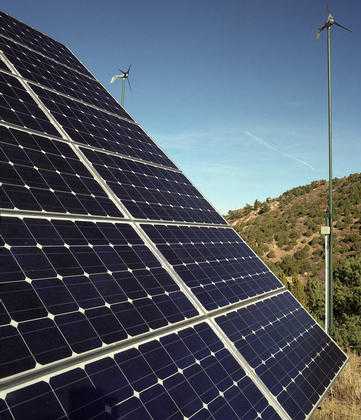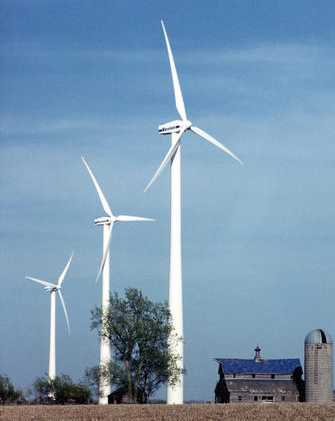on Markets, Policy, Investment, and Future Pathways
by Eric Martinot


|
Renewable Energy Information on Markets, Policy, Investment, and Future Pathways by Eric Martinot |
 |
 |
Productive uses are an emerging area of research and investment. The following information is only a first attempt to show current understanding and practice. Subsequent updates are planned. Comments, additions, and case studies are welcomed for the next version. Please send to contact@martinot.info.
BASIC REFERENCES AND RESOURCES
Solar Photovoltaics for Sustainable Agriculture and Rural Development, B. van Campen, D. Guidi, G. Best (Food and Agriculture Organization of the United Nations, Rome, 2000), 76 pages.
Renewable Energy for Microenterprise, April Allderdice and John H. Rogers (National Renewable Energy Laboratory, Golden, CO, 2000), 71 pages.
GEF-FAO Workshop on Productive Uses of Renewable Energy -- Executive Summary, Eric Martinot (Global Environment Facility, Washington, DC, 2002), 6 pages.
GEF-FAO Workshop on Productive Uses of Renewable Energy -- Synthesis and Report, Ron White (Global Environment Facility, Washington, DC, 2003), 43 pages.
Renewable Energy for Productive Uses: Strategies to Enhance Environmental Protection and the Quality of Rural Life, Jose Etcheverry (University of Toronto, 2003), 50 pages.
Survey of Productive Uses of Electricity in Rural Areas, Robert E. Fishbein (World Bank, Washington, DC, 2003), 51 pages.
Productive Uses of Renewable Energy: A Review of Four Bank-GEF Projects, Kamal Kapadia (World Bank, Washington, DC, January 2004 draft version), 33 pages.
Sustainable Energy Strategies -- Materials for Decision Makers, Chapter 4 on Renewable Energy, J. Weingart, S. Kartha, and G. Leach (UNDP, New York, 2000), 50 pages.
"Renewable energy markets in developing countries," Eric Martinot, Akanksha Chaurey, Debra Lew, Jose Roberto Moreira, and Njeri Wamukonya, Annual Review of Energy and the Environment 27: 309-348 (2002).
CASE STUDIES AND FURTHER INFORMATION BY APPLICATION
(examples and links still under development)
| Application | Examples |
| 1. Food Production and Storage | Water pumping for crop irrigation |
| Water pumping for cattle | |
| Electric livestock fences | |
| Aeration pumps for fish and shrimp farms | |
| Egg incubators | |
| Refrigeration for storage (fruit, milk, etc.) | |
| Ice making for storage (fish, etc.) | |
| 2. Food Processing | Meat and fish drying |
| Plant/seaweed drying | |
| Spice drying | |
| Cereal grain processing | |
| Coconut fiber processing | |
| Grain mills | |
| Lighting for processing plants | |
| 3. Materials Processing | Gypsum processing |
| Rubber drying | |
| Sawmills | |
| Silk production | |
| Silkworm rearing | |
| Textile dyeing | |
| 4. Cottage Industry | Bakeries (ovens) |
| Bicycle repair (power tools) | |
| Brick making (kilns) | |
| Carpentry (power tools) | |
| Electronics repair (soldering irons) | |
| Handcraft production (small electric tools) | |
| Sewing (sewing machines) | |
| Welding (welders) | |
| Wood-working (drills, lathes) | |
| Workshop (small electric tools) | |
| Lighting for work places | |
| 5. Drinking Water | Desalination |
| Potable water pumping | |
| UV or ozone water purification | |
| 6. Education | Computer/internet |
| Video | |
| School lighting | |
| 7. Health Care | Small medical equipment |
| Vaccine/medicine refrigeration | |
| Computer/internet for telemedicine | |
| Clinic lighting | |
| 8. Community Services | Broadcast media |
| Village cinema | |
| Cellular/satellite telephone/fax | |
| Computer/internet e-commerce | |
| Community center lighting | |
| Street lighting |
FOOD PRODUCTION AND STORAGE
Thinking big: solar water pumping in the Punjab, Jos van den Akker and Hemant Lamba, RE-focus, Nov/Dec 2002, pp. 40-43.
Institutions matter, but are they sufficient for enhancing all markets?
Examining the role of the state in promoting off-grid PV technology for
productive uses in Punjab, India, Verena Radulovic, Master's thesis, London School of Economics, 2003.
World Bank/GEF Mexico Renewable Energy for Agriculture Project
The rainmaker: how a low-cost, lightweight pump is changing the economy of a nation, by Lisa Margonelli, WIRED, April 2002. Story of how a Nairobi-based nonprofit company, Appropriate Technologies for Enterprise Creation, is changing the lives of rural farmers with its manual irrigation pump.
Renewable Energy and Agriculture: A Natural Fit (Union of Concerned Scientists, 2003). Good background information, plus a series of fact sheets linked to the page on wind power and agriculture, biomass and agriculture, and solar energy and agriculture.
Solar Water Pumping for Cattle in The Gambia (Grundfos web site, 2003).
Case Study: Resource-Conserving Irrigation with Photovoltaic Water Pumps in Chile (GTZ, Eschborn, Germany, 2002).
FOOD AND MATERIALS PROCESSING
Seaweed Drying from a Village-Scale Hybrid System on Atulayan Island, Philippines. Also supports cottage industries like woodworking and sewing.
Energy Strategies for Rural India: Evidence from Six States, D. Barnes, et. al., ESMAP Report 258/02 (ESMAP/UNDP, Washington, DC, 2002). Contains surveys of artisans and cottage industry, agricultural water pumping, plus food and materials processing. Some uses of renewable energy are documented.
Mali Multi-Function Platform. Powers a variety of food processing activities plus water pumping, welding, and other needs. Diesel powered, not renewable energy, but illustrates the productive applications also possible in the case where renewable energy replaces diesel.
COTTAGE INDUSTRY
Home Employment and Lighting Package (HELP) by the Himalayan Light Foundation is assisting villagers to produce and sell paper and paper products, knit bags, art works, and other handicrafts, using solar-powered home lighting and telecommunications. One of the package's innovations is a financing mechanism that doesn't require collateral and allows repayment of solar equipment costs from future sales of home-made products.
Solar PV for Micro-Enterprise. Grameen Shakti provides solar PV for households and a variety of productive uses, including village cell-phone services, rice mills, tailor shops, saw mills, grocery shops, poultry farms, restaurants, bazaars, TV repair shops.
Energy Strategies for Rural India: Evidence from Six States, D. Barnes, et. al., ESMAP Report 258/02 (ESMAP/UNDP, Washington, DC, 2002). Contains surveys of artisans and cottage industry, agricultural water pumping, plus food and materials processing. Some uses of renewable energy are documented.
DRINKING WATER
A Case Study and an Emerging Model: Renewable Energy for Rural Community Water Supply in the Dominican Republic, Shannon Graham and Eric Johnson (Enersol, Chelmsford, MA, 2000). Eight PV-powered village water systems provide daily water service to about 1000 people. The cost of this water over the system lifetime was estimated at about 1.5 cents/gallon, compared to 2.5 cents/gallon for water delivered by private truck in large drums. Users pay for water on a per-gallon basis and prefer the service to existing water supplies.
South Africa Solar Water Pumping System Improves Quality of Life (Grundfos web site, 2003; originally appeared in Solarbuzz news, October 31, 2002).
Lotus Energy Solar Photovoltaic Water Pumping Project in Nepal (NREL/RVSP website, 2000).
Case Study: Resource-Conserving Drinking Water with Photovoltaic Water Pumps (GTZ, Eschborn, Germany, 2002, and IEA PVPS Task IX, Paris, 2003). Installed over 90 PV water pumping systems from 1990-1998 in Argentina, Brazil, Indonesia, Jordan, the Philippines, Tunisia and Zimbabwe. Those systems provide potable water to people of the village communities and their livestock.
EDUCATION
Solar-powered Computers for Rural Schools (Enersol website, 2003). Sixteen projects for bringing solar-powered laptop computers to schools in Dominican Republic, Haiti, and Honduras.
Project for Solar High School in KwaZulu Natal, South Africa, by the Solar Electric Light Fund.
Mphaphati Solar Village: Community PV in Swaziland. A community scheme based around a village school that also includes water pumping and solar street lights, Jonathan Curren, Renewable Energy World, March-April 2003, pp. 83-91.
Renewable Energy for Community Development, Education, and Health Care on a Brazilian Island (NREL, Golden, CO, 1997).
HEALTH CARE
Cuba Revolutionary Health Care PV-Powered, Laurie Stone, Home Power magazine, Aug/Sep 1998.
Fact Sheet: Solar Energy and Rural Health Care, Fact Sheet N132 (World Heath Organization web site, 1996)
World Bank/GEF Uganda Rural Energy for Development Project
COMMUNITY SERVICES
Somos@Telecentros is a Latin America network of community internet access centers (telecenters), some powered by solar. The web site provides analysis of lessons learned.
Rural Community ICT Applications: The Kothmale Model, Pringle,
I. and David, M.J.R., The Electronic Journal on Information Systems in Developing Countries 8(4): 1-14 (2002). [Not renewable energy in this specific case, but an illustrative case nonetheless] Kothmale Community Radio (KCR) in Kothmale, Sri Lanka, is making communities aware of information and communication technologies. Staff use a single computer with Internet access to reach thousands of people within its 20 km broadcasting radius.
Telecenters for Socioeconomic and Rural Development in Latin America and the Carribean, Proenza et al (IADB, Washington, DC, 2001).
Greenstar Solar Community Centers in West Bank (Palestine), Jamaica, India, and Ghana.
Page updated January 27, 2004
Photo credits C. Babcock, W. Gretz and
DOE/NREL Photo Information Exchange